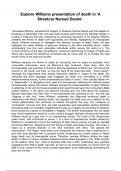Explore Williams presentation of death in ‘A
Streetcar Named Desire’.
'Tennessee Williams' expressionist tragedy, A Streetcar Named Desire was rst staged on
Broadway in December 1947 and was most recently performed at the Almeida Theatre in
London in February this year underlining its continuing relevance. In his tragedy, Williams
presents the theme of death both guratively and literally, highlighting its inescapable
nature. Whether physical or intangible, the abstract concept of death within the play
highlights the harsh realities of post-war America in the New industrial South, further
emphasising how the most vulnerable individuals within society fall victim to it. The
cyclical structure of the play and Williams' conscious intertwining of images of death and
desire also expose the disastrous consequences for those who try to escape the rigid
social norms of the post-war society.
Williams explores the theme of death by conveying how its preys on societies most
vulnerable individuals, such as Blanche's late husband, Allan Grey, after his
homosexuality was exposed. In Scene 6, Blanche describes to Mitch how “he’d stuck the
revolver in his mouth and red- so that the back of his head had been - blown away!”.
Although the fragmented lines display Blanche’s distress in regard to his death, the
colloquial and blunt language used suggests his death was normalised in a 1940s
heteronormative society, further emphasised by Stella in scene 7 who casually labels him
a “degenerate” - a derogatory term used for homosexuals, re ecting the attitude toward
homosexuality during this period. Perhaps through the characterisation of Allan, Williams
is re ecting on his own homosexual desires that were frowned upon by his Southern Belle
mother Edwina, in the same way Blanche frowned upon the truth about her husband.
Blanche describes how Allan was “in the quicksands and clutching at me”, but she was
“slipping in with him”. Here Williams’ evidences how Blanches emotional death is
intertwined with Allan’s physical death, and arguably his death acts as a catalyst for her
mental deterioration that continues to decline throughout the play. The metaphor of
“quicksand” conveys how they are both perpetually and inescapably sinking therefore
illustrating death as inevitable, heightening the play as a tragedy as according to Aristotle,
there should be a sense of inevitability in tragedy. This further emphasises how the death
they would experience would be a slow, painful struggle, perhaps mirroring the adversity
Williams faced as a gay man in an unaccepting society. The motif of the Varsouviana
polka music, rst introduced in scene 1, is a form of expressionist theatre utilised by
Williams to consistently remind the audience of Allan Grey's suicide, as well as mentally
tormenting Blanche, displaying how the theme of death permeates the play. The music is
heard as it reminds Blanche of her nal moments with Allan; “we danced the
varsouviana”. The happy, lively polka tune juxtaposes the memory that is attached to it,
and only ends abruptly with a gunshot sound, evidencing the violent nature of Allans
tragic death and its inescapable nature. Therefore, perhaps Williams utilises the tragic
death of Allan to critique outdated heteronormative ideals prevalent in the 1940s society,
as the epithet “Grey boy” used to describe Allan has a dark, foreboding tone, perhaps
suggesting that Allan’s death was fate, as due to his homosexuality he would never be
able to truly conform to the harsh societal expectation to be heterosexual dominating the
post-war society.
fl fi fi fi fi fl fi




